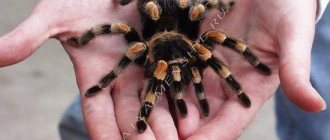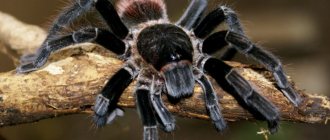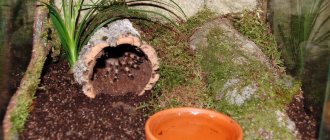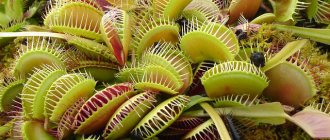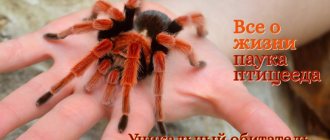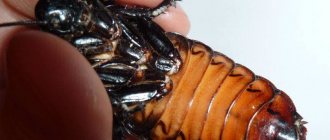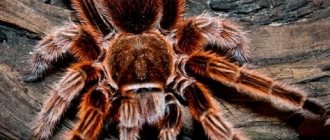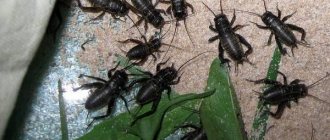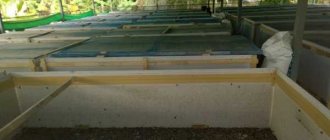Every novice arachnid breeder sooner or later is faced with the question of choosing a convenient terrarium for their pet. Keeping a representative of an exotic species is not as easy as it might seem at first glance. Especially when it comes to tarantulas.
Most arachnophiles acquire low-maintenance spiders. So what should be a suitable terrarium for a tarantula spider to make it comfortable?
Terrarium for a tarantula spider
Tarantulas should be kept in small (up to 30x30x30 cm) terrariums, in which there is free access to air (from above and, very preferably, from the side). The terrarium must be securely closed so that animals and children cannot get there. Do not place the container with the spider in direct sunlight, or near audio speakers or other sources of strong vibration. It should be remembered that nicotine is a strong insecticide and it is advisable that the smoke does not get into the container with the spider. In the summer, it is better not to use mosquito repellent aerosols or fumigators in a room with a spider.
Very often, beginners want to equip a tarantula with a huge terrarium, but this is unnecessary. Tarantula spiders in nature live in burrows, under snags, stones and in any other small and secluded places. Therefore, unlike cats and dogs, they require very little space to live. Remember that the smaller the container, the easier it is to monitor the spider and, most importantly, feed it! The optimal size of the terrarium is two to three times larger than the spider's leg span in an extended position. For terrestrial tarantula spiders, the height of the terrarium plays a vital role, so it should not exceed 25-30 cm. Otherwise, falling even from 50 cm, a large spider can rupture its abdomen, which will lead to a slow and painful death.
Tarantulas can be kept both in inexpensive plastic terrariums and in professional glass ones, with flow ventilation and doors for easy access to the spider. In any case, it is very important that there is good ventilation. This will reduce the likelihood of mold, mildew, mites and other hazards in a humid environment.
Tarantula spiders do not need plants or any decorations, but they can be used to decorate a terrarium. Remember, living plants with “natural” soil may contain parasites, which will have a detrimental effect on the spider, so it is better to give preference to artificial ones. There are so many great imitations of real plants now available that can look even better than their living counterparts.
The vital necessities for tarantulas are a terrarium, coconut substrate, drinking bowl, shelter and heating (provided that your temperature is below 23°C). Everything else is decoration and pleasant little things that will make caring for the spider easier, but will not affect the life and health of the spider.
Widespread species of spiders in Russia
Poisonous spiders make up only a small part of the total species diversity in Russia.
Non-poisonous species are ubiquitous and pose no danger to humans. Moreover, they are orderlies who destroy other insects that are more dangerous to people. Next we will tell you about other types of spiders in Russia.
But first it is worth noting that the largest spider in Russia is the South Russian tarantula, which we have already reviewed. But we will describe other popular inhabitants of our area below.
Horses
Another name is jumping spider. Distributed everywhere. He can often be found basking in the sun. Males and females reach a size of 5-6 mm. There are 4 pairs of eyes on the cephalothorax: 2 of which are very large and mobile. The arthropod's vision is very good. It allows you to estimate the distance to prey.
Does not weave cobwebs. It attacks the victim from an ambush. Before jumping, the horse attaches itself to the surface with a thread of web so as not to be damaged as a result of a fall.
The horse is poisonous, but very small. Its fangs are not capable of cutting through human skin. In addition, this species is not aggressive.
Hunters
Hunters or dolomedes are spiders of central Russia. They prefer high humidity, and therefore settle on the banks of reservoirs, near swamps and in wet meadows.
Females reach 2.2 cm in length, males are twice as small. Body color is yellow-brown. Two parallel white stripes run along the cephalothorax and abdomen.
This species is able to move along the surface of the water and even dive. It does not dig holes, but settles in the greenery of coastal vegetation. The animal hunts not only insects, but also fish fry, which it drags onto land for a meal. The hunter is not dangerous to people.
Funnel
Funnel-web spiders are quite common in Russia. Another name for them is house spiders. The body is beige-brown in color. There are two thin dark stripes on the cephalothorax and abdomen.
The abdomen is elongated. The front pair of walking legs is much longer than the others. The arthropod weaves a funnel-shaped web. It can be sticky or non-sticky.
The spider is quite aggressive, but almost not dangerous to people. Its poison is not so toxic as to cause significant harm to the human body. However, cases of necrosis have been reported.
Orb weavers
Several species of the orb weaver family are common in the Russian Federation. These include the crosses that we talked about earlier. This family is famous for its ability to spin large webs.
Appearance may vary depending on the species. They are united by the presence of a spinous process on the last pair of legs. It is needed for weaving webs. Orb weavers are also found in northern Russia. They live wherever they can get food.
Synanthropic species
Synanthropic spiders live in Russia - these are species that choose human dwellings to live. They are often harmless to humans.
One of the most common is the centipede. She often lives between window frames or weaves webs in dark corners. It stands out for its long limbs relative to the body. Absolutely non-aggressive and too small to harm a person.
Window spiders often live under window sills. They reach 1 cm in size. The body is black, on which you can sometimes see a yellow pattern.
The black hobo spider is also often found indoors. He does not weave webs, he hunts from ambush. Stays in the dwelling as long as there is prey for it, and then leaves.
Humidity and drinking bowl for tarantula spider
Moisture is the most important criterion when keeping tarantulas. To maintain the required level of humidity, it is necessary to periodically spray the soil with settled water or water from a filter. It is necessary to place a drinking bowl on the ground, which should always contain fresh water. You can use a special decorative drinking bowl for small animals, which is made so that the animal can freely get out of it and not drown. As a compromise, you can use a plastic jar lid or any other shallow container. It is advisable to install it under the wall of the terrarium. At night, in search of food, spiders stumble upon a drinking bowl and replenish their water supplies. To measure humidity, you can use a special hygrometer for terrariums, which can be positioned so that it is hardly noticeable and at the same time performs its direct function. Remember, you can’t make a swamp in the terrarium! Excessive amounts of water can cause mold and mildew to develop, which can kill the tarantula.
Video: How to make a terrarium for plants?
Today I want to tell you how to make a terrarium for a spider, scorpion or any other terrarium inhabitant from a plastic laundry container, which is sold in a hardware store and is relatively inexpensive. My container with dimensions 35x20x20 length, width and height cost 290 rubles.
First, let’s ask ourselves the question: “What is the difference between plastic terrariums sold in pet stores and laundry containers sold in hardware stores?” And the answer is simple: “terrariums” from pet stores have ventilation and a convenient handle for carrying, that’s all. In the case of my container, there is no handle, but I don’t really need it.
Temperature and heating for the tarantula spider
For full development, the spider requires an average room temperature of 23-28°C. If the room is colder, then you can use thermoplates for terrariums. They come in all sizes, attach to any surface and are suitable for all types of terrariums. They also need to be used for some species of tarantulas that require elevated temperatures of 28-30 °C and above. To measure the temperature inside the terrarium you will need a thermometer. Remember that a sharp drop in temperature of even 5 degrees can be fatal for some species of tarantulas!
Popular types of house spiders
The category of the most popular species includes spiders, which are perfectly adapted for keeping in captivity, are completely unpretentious, and also have an unusual appearance:
- The curly-haired tarantula spider or Brachyelma albumilosum is an unpretentious ambush spider that leads a nocturnal lifestyle. An ideal exotic option for beginners, thanks to its original appearance, fairly large body size, and amazing calmness. It is not brightly colored, and its unusual appearance is due to the presence of fairly long hairs with black or white tips. The main color of the spider is brown or brownish-black. The average body length is 80 mm with paw sizes of 16-18 cm. The cost of an adult individual reaches four thousand rubles;
- Acanthoscurria Antillensis or Acanthosсurria antillensis is a spider native to the Lesser Antilles. The species belongs to the family Tarantulas. This is a fairly active spider that hides in a shelter during the day and feeds on various insects. The body length reaches 60-70 mm with a leg span of 15 cm. The main color is dark brown with a slight metallic sheen on the carapace. The average cost of an adult reaches 4.5 thousand rubles;
- chromatopelma Cyaneopubescens Chromatorelma cyaneopubescens is a popular and very beautiful tarantula spider, which is characterized by a body length of 60-70 mm, as well as a leg span of up to 14-15 cm. The main coloring is represented by a combination of a reddish-orange abdomen, bright blue limbs and green carapace. A hardy species that can survive without food for several months. The average cost of an adult reaches 10-11 thousand rubles;
- crаssiсrus lamanai is a species safe for humans, characterized by the presence of expanded joints in the area of the fourth leg in females. The main coloring of an adult male is black. The body size of the male is up to 3.7 cm and the carapace is 1.6x1.4 cm. Mature females are much larger than males and their body length reaches 7 cm with a leg span of 15 cm. Adult females are colored predominantly in brown tones. The average cost of an adult reaches 4.5 thousand rubles;
- Cyclosternum fasciatum is one of the smallest in size, a tropical species of tarantula spider native to Costa Rica. The maximum leg span of an adult is 10-12 cm with a body length of 35-50 mm. Body color is dark brown with a noticeable reddish tint. The cephalothorax area is colored reddish or brown, the abdomen is black with red stripes, and the legs are gray, black or brown. The average cost of an adult reaches 4 thousand rubles.
Also popular among lovers of domestic exotics are such species of spiders as Cyriocosmus bertae, Grammostola golden-striped and pink, poisonous Teraphosa blondie.
Lighting for tarantula spider
Tarantula spiders are nocturnal animals, so there is no need to worry that your pet is not getting enough light. Quite the contrary, the less light, the better! The terrarium should be in a dark place. For full visibility inside the terrarium, you can use moonlight lamps. They will create an imitation of the night tropics. At the same time, you will be able to observe the spider without creating a stressful situation for it. You cannot place the terrarium in direct sunlight, because... a spider can easily “fry” in the summer sun! Do not use ordinary incandescent lamps to illuminate the terrarium - they dry out and heat the air, and most terrarium accessories can easily melt and even catch fire from high temperatures.
Heating in the terrarium
In most cases, it is necessary to heat the terrarium during intervals when it is already quite cold and the batteries are not turned on or off. At this time it can be cool in the apartments. The following types of heating are suitable: a thermal mat, a thermal cable, special stones and driftwood; also, a regular incandescent light bulb is suitable as a heating device, which it is advisable to darken and install outside the terrarium, since a spider can easily get burned on it, in addition, such light bulbs greatly dry the air, which not suitable for spiders. It is also advisable to purchase a thermostat that will maintain the temperature at a certain level.
Food and feeding of the tarantula spider
Tarantula spiders are predators. Their food is any creature suitable in size. Adults can even feed on frogs, mice and lizards (but this is not necessary). The size of the food object should not exceed half the spider’s body, otherwise the spider will be afraid, which will lead to constant stress and further refusal of food. The main food of spiders is insects. There is now a large range of specially grown food insects for terrarium animals that are suitable for all stages of spider development. Do not feed the tarantula with caught insects or animals from nature, because they may carry diseases and/or be treated with chemicals! Remember not to throw many insects at a spider at once! It is necessary to remove the remains of food items in the terrarium within 24 hours, otherwise this can lead to mold and the proliferation of parasites! Do not give your tarantula food the week before and the week after it moults.
Tarantulas should be fed as much as they want. The more often a spider eats, the faster it grows, of course, if it has an appetite. If the spider does not refuse food, then you can give food at least every day, but if you throw an insect and the spider runs away from it (and it is small), try cutting it in half. If this does not force the spider to eat during the day, it means that it is not hungry and, perhaps, is preparing to molt.
What age should I take a spider?
Finally, you have decided on the type and begin to look for where to buy the pet you need. Almost immediately you come across a ton of advertisements, but for some reason they have a big difference in price. The fact is that the cost of a spider depends on age and gender. And then you say that it’s easier to buy a small spider, watch it grow, and the price is quite satisfactory. That’s how it is, but it’s better not to do this without experience in content. Young spiders are tiny and require much more care than adults, and besides, it is much more difficult to find food for small spiders than for an adult. As for gender, it is worth noting that male tarantulas live much shorter than females, and they are also much smaller in size, and therefore they are rarely of collection value. There are species in which the males are much more beautiful and brighter than the females, but this is a very rare case. Therefore, if you want the spider to live with you as long as possible, then you should get a female.
Kit for tarantula of the genus Caribena (Avicularia) “Standard”
Handling a tarantula
Remember, the tarantula spider is not a guinea pig or a cat, it is not a contact animal and it is extremely undesirable to handle even “innocent” species! First of all, for the safety of the spider itself! Tarantulas can unexpectedly run very quickly and fall from your hand onto the floor, and falling even from 50 cm onto a hard surface can lead to a rupture of the abdomen and death of the spider. Even the quietest and most peaceful spider can bite, so this is the second point why they should not be picked up. If we haven’t convinced you and you really want to “snuggle” your pet, then here are a few recommendations that will protect you and the tarantula:
- do not make sudden movements, do everything smoothly and slowly;
- do not blow on the spider, because he can run sharply and fall from his hand;
- keep quiet;
- avoid sharp flashes of light;
- do not press it;
- do not do anything that could cause a stressful situation for the spider;
- In any case, you need to be extremely careful.
The safest and most proven way to pick up a spider is to gradually push the spider onto your hand lying on a flat surface so that the spider itself climbs onto your palm. To return the spider, you need to do the same operation only in reverse order.
Choosing a home
After choosing a spider, you should think about where it will live. For a spider, it doesn’t matter where to live, the main thing is that the conditions there are good. Food containers can serve this purpose - this will be the best home for the spider if it is still small. You need to make holes in the container for ventilation, fill it with soil and that’s it. Convenient, practical, not expensive. However, if you decide to provide the spider with a more beautiful home, then for this purpose you will already need a terrarium. How to choose a terrarium? It all depends on the type of spider: there are terrestrial, burrowing, arboreal and intermediate species. It is worth considering that the type of young and adult spiders may differ. For ground spiders, horizontal or cubic terrariums are suitable. These spiders can be found much more often walking around your home. For burrows, both a horizontal and a cubic terrarium may be suitable, but it is worth considering that a large amount of soil should be poured into it. In addition, burrow spiders really do not like to be in plain sight and come to the surface only at nightfall, while semi-burrowing species can stay near the burrow and hide in case of danger. Woody species require a vertical terrarium. Such spiders will build air tunnels from their webs, sometimes embedding a small amount of soil into them to strengthen their homes. Regarding the size of the terrarium, it should be said that you should not strive to purchase a huge terrarium, since the animal will be constantly under stress, and this will affect its health. The fact is that spiders prefer to be safe in narrow conditions, so if you put a spider in a large space, you risk its health. In the wild, spiders also look for any voids, cracks in trees, or hollows, or even dig holes themselves where they feel safe. You can arrange the terrarium itself by putting in it shelters for the spider, all kinds of driftwood and decorations. Such arrangement is sometimes even necessary, especially for tree species that require a foundation for building a home. However, when installing natural decor, such as live plants, driftwood, or bark, into a terrarium, you need to be careful - organic materials can begin to rot or mold, and pathogenic bacteria can also develop on them. Such materials should be treated thermally, but in no case should insecticides or toxic substances be used, as they can harm the spider.

